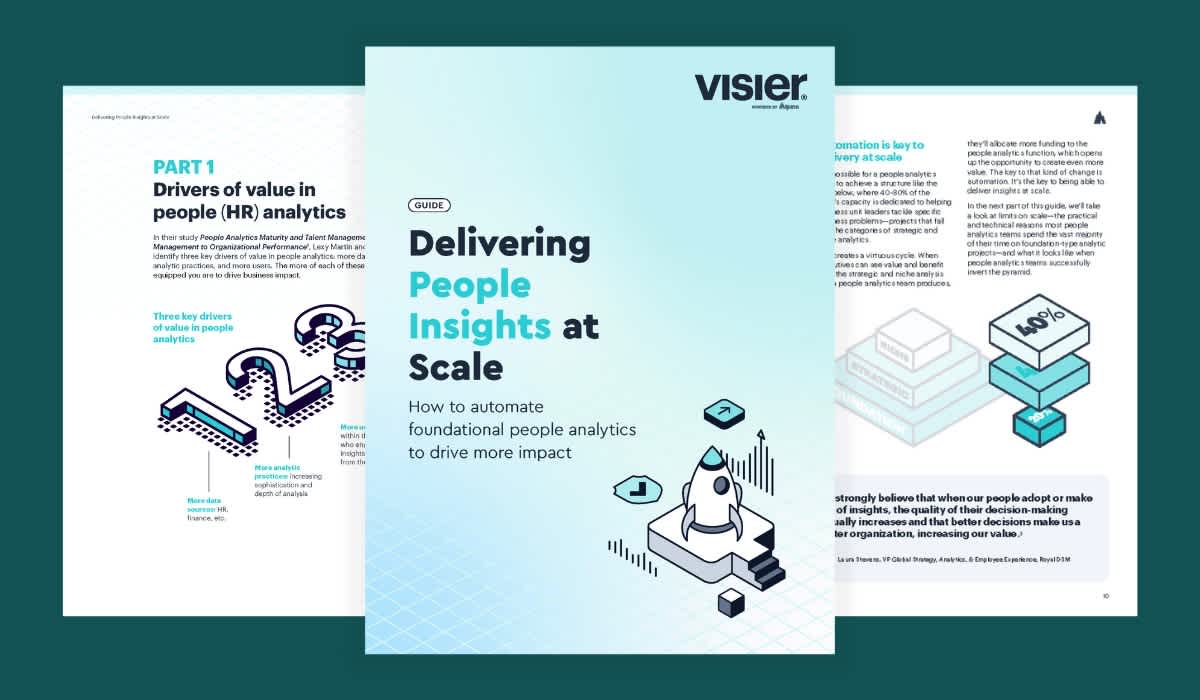Aggregating Data Across Your HR Tech Stack
Discover how to optimize your HR tech stack to improve data management, maximize ROI, and drive strategic business outcomes with real-time insights. Read more.

The tools used by Human Resources (HR) departments have evolved significantly over the years from manual spreadsheets and systems of records to software solutions. Ten years ago, we started digitalizing our processes through all-in-one software, focusing more on a one-size-fits-all approach to move away from the tedium of spreadsheets. Today, as HR technology becomes more sophisticated, organizations are opting for best-of-breed HR and people analytics platforms to drive business value.
But with a plethora of tools at our disposal, conversations around HR data optimization and aggregation are becoming a key topic of discussion among HR tech and people analytics leaders. Organizations need the ability to connect all of their systems into one single source of truth, and people analytics is an essential key to making this happen.

Getting the HR tech stack right to hit the fundamentals
Ian Cook, Visier's VP of Product Management, recently held a webinar for People Analytics World on Optimizing your HR Tech Ecosystem for Strategic Impact, with guest panelists Angela Le Mathon, VP of People Data & Analytics at GSK, Peter Schulz-Rittich, Group SVP, Global Head of People & Culture Transformation, Platforms and Data at ISS, and Jorn Waterschoot, Global Head of HR Technology at Bekaert.
Together, this group discussed how they each use people analytics and their HR tech stack to drive strategic business impact. Each organization is at a different maturity level in its HR tech stack, but what I found most interesting was they shared a mutual goal across the board: How can we use all the data in the HR tool arsenal to drive business value and gain the ROI of all our tool and analytics efforts?
Aggregating HR data into one system
One of the fundamental challenges in building an effective HR tech stack is aggregating data from various silos. HR organizations rely on multiple sources of data—including employee surveys, performance management tools, payroll systems, applicant tracking systems (ATS), engagement platforms, and learning and development tools. When they’re not connected, it creates barriers to people analytics efforts. This challenge is further compounded for global organizations, where different regions or countries may use their own localized solutions.
There's no one-size-fits-all approach to harmonizing HR systems across a global organization. Different regions often have unique compliance requirements, cultural nuances, and operational needs that demand tailored solutions. While forcing a fully globalized system may not be feasible, it's essential to establish parameters for organization-wide insights.
The key lies in striking a balance between respecting local variances and maintaining global consistency. This approach allows for meaningful comparisons and holistic workforce analysis while accommodating necessary regional differences.
You could extract the data for each system, analyze it, and gather insights upon request. However, disparate systems often mean inconsistent data definitions, varied data quality, and challenges in data governance. With an integrated HR tech ecosystem, you allow for seamless data sharing and analysis across different HR and people analytics tools.
"It's crucial to keep things connected...As soon as your landscape starts expanding, you need to be organised to keep things consolidated and connected."
Jorn Waterschoot, Global Head of HR Technology, Bekaert
Connecting all your HR tools and solutions is core to an effective data management strategy—it simplifies the process of collecting, organizing, and cleaning data, which are required before it can be used to gain key organizational insights.
When data can be aggregated in real-time to provide an accurate view of the workforce, organizations can identify patterns and trends, make data-driven decisions, and ultimately drive business outcomes—all from a centralized source.

Maximizing your HR tech stack return on investment
The true value of HR technology lies not just in tool optimization, but in the integration of these systems to provide real-time, actionable insights. By connecting HR and operational data, organizations can address pressing business questions and achieve a tangible ROI on their tech investments.
How I like to put it is gaining insight into the unknown unknowns. With a connected HR tech ecosystem, organizations can uncover insights that were previously invisible due to data silos and disparate systems. It gives you reliable data in real time that can be analyzed with confidence to uncover valuable insights that drive business outcomes.
Using genAI tools to make insights more accessible
With the advent of AI and large language models (LLMs), the potential for HR tech and HCM optimization is only going to continue growing. I am a big advocate for using AI and LLMs to scale self-service people analytics. Visier's generative AI Digital Assistant, Vee, makes self-serve analytics accessible across organizations by providing a simple, conversational interface where users can ask people-related questions and receive instant answers.
The benefits of using AI in HR tech ecosystems are significant. It allows for data productization, the democratization of insights, and, ultimately, faster decision-making. However, one thing cannot be overlooked—the data infrastructure that feeds it. Organizations must ensure their data practices meet compliance requirements. There are various AI regulations, like the EU AI Act and the U.S. AI Bill of Rights, which are regularly evolving as the use of AI expands.
If the data isn't cleaned or the information fed to the AI is biased, then the ethical use can be highly questioned—not just morally in terms of doing the right thing, but also on a regulatory level. At the end of the day, if the model you are using is not ethical, there will be no business value.
"If you don't have data, you really can't leverage AI. We need to build those foundational components to make sure that we can leverage those AI models correctly. We need to really then understand how the AI models are working in these various platforms, how they work together when you start to create those integrations."
-Angela Le Mathon, VP of People Data & Analytics, GSK
It's critical to have a robust data infrastructure and HR data management strategy in place before embarking on the AI and LLM journey. However, this is not something that can be done in isolation; it needs a holistic approach, incorporating all aspects of the organization and its data sources.

Key takeaways
To maximize your HR technology stack and drive true business outcomes, you need a connected people analytics HR tech ecosystem that enables deep insights by combining HR data with non-HR data.
Organizations must focus on integrating these tools to create a cohesive HR tech ecosystem in order to derive meaningful insights and drive business value. No matter where you are in your journey, this requires a robust data infrastructure, a strategic approach to globalization and standardization, and a commitment to ethical AI use. Only then, by addressing these challenges head-on, can HR leaders unlock the full potential of their tech stacks and support their organizations in achieving sustainable success.
Want to learn more? Connect with us to see how we can help you achieve HR tech optimization to drive strategic business decisions.



